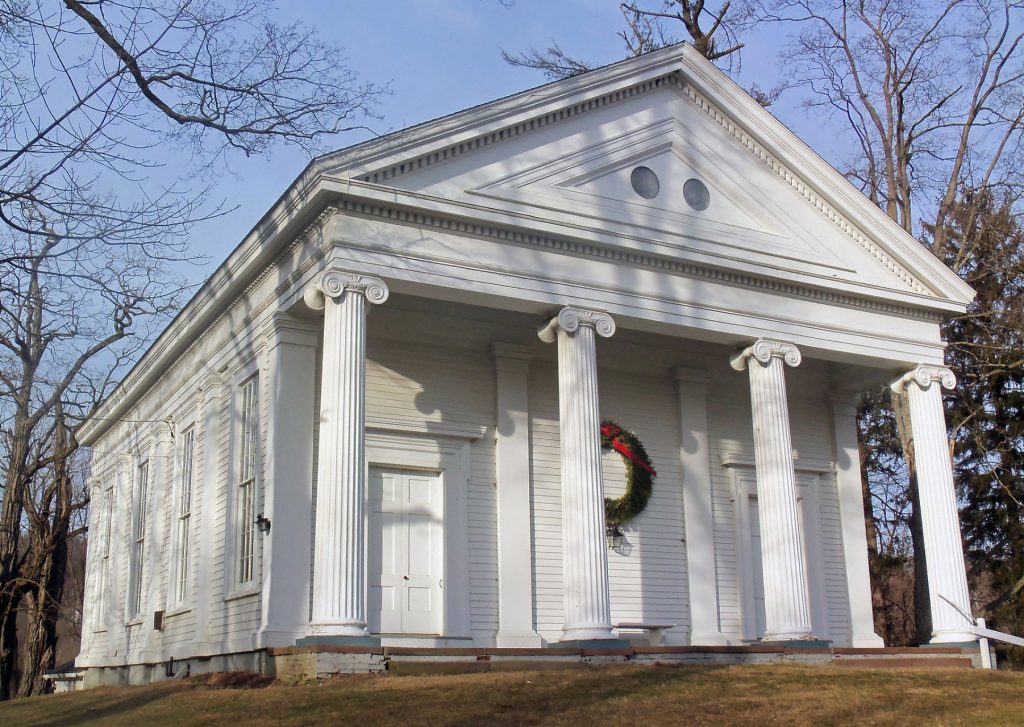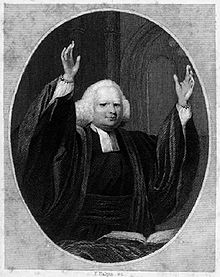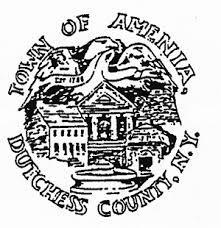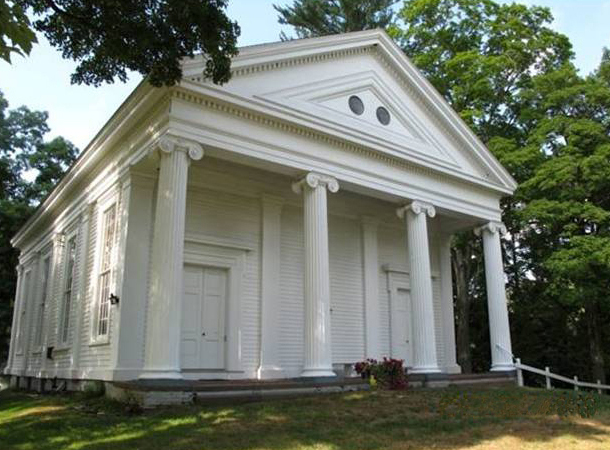
by Clerk Kevin T McEneaney for the Millbrook Historical Society, 6/20/24
The first settler in this area was Richard Sackett, in about 1702; he settled along the Wassaic Creek, having purchased 7,500 acres from the colonial government in 1703. Other settlers began arriving around 1710. The first county census in 1714, counted 445 inhabitants and 29 slaves. Many of the settlers were in Poughkeepsie. Some had patents from England, while others had patents from the colonial government. By 1723 the population was 3,078 with 52 slaves. Three log cabin squatters appeared in this neighborhood; the land these squatters occupied was derisively, or humorously, referred to as “The City. ”
At that time, New York State and Connecticut claimed this area with Connecticut having the stronger claim. The disputed border between New York and Connecticut was finally settled on May 14, 1733, when New York State traded a small strip of northeastern land on the Atlantic coast for a sliver of land that would run parallel to the Hudson River because New York wanted to regularize its border with Massachusetts and Vermont. This land of 61,440 acres was called the Oblong; large tracts of it were sold to individual investors.
Christian Henry Rauch, a Moravian from Bethlehem, PA, arrived in New York City on July 16, 1740, and met with a delegation of Mahican Indians who had come to Manhattan determined to settle land issues. Rauch discovered that he could converse in Dutch with two Mahicans, Tschoop and Shabash, who were also somewhat acquainted with English from their contact with settlers along the Hudson; they invited Rauch to Shekomeko village; he visited them, sleeping in their cabins and converted them.
Rauch then returned to Bethlehem with three Mahicans to attend the Oley Synod, at which he was ordained a deacon by bishops Nitschman and Zinzendorf. Rauch then baptized Shabash, Sein, and Kiop; all four returned in August to Shekomeko where Rauch baptized Tschoop (who was in poor health). They celebrated their first communion service in a tent.
In the winter of 1742, a religious society was founded by the Smith family at The City. Members may have met in their homes or at The City Meetinghouse. This society aspired to build a religious community, the likely denominational preference being Presbyterian, since the Smith family originated from Wales. They needed to raise money to build a church, which was addressed by annual tithing. Since then, for 282 years, that society has been meeting annually on the last Sunday in January.
On August 27, 1742, Bishop Zinzendorf arrived with his daughter Benigna in Bethel. After preaching, Zinzendorf converted six other natives and baptized them. In 1742 Rauch also preached to those landowners around The City with the aspiration of founding a church.
Some local settlers were accustomed to manipulating the Natives through alcohol and heartily resented the presence of Rauch and the Native Christian community established by the Moravians. Rauch convinced the Mahicans they should turn to temperance; there was resentment among those selling liquor about the lack of liquor sales.
A friend of Rauch, Johannes Rau, a Palatine who was friendly with the Moravians, told Rauch that those illegal squatters in the area were “more like incarnate devils than human beings.” (De Cost Smith, Martyrs of the Oblong, 58.) On December 15, 1744, the sheriff and three peace officers of Dutchess County appeared at Bethel under orders from Governor Clinton to give the missionaries notice to cease their teachings; the Moravian leaders were summoned to appear in court at Poughkeepsie.
On December 17, 1744, the Poughkeepsie court ordered the Mahicans in Shekomeko and Bethel to leave the county because they had no deed of ownership. (Dutchess County Federal Guide, p. 111, 1937)
The first Christian church built in our area (1744-5) was in the hamlet of Bethel, built by Moravian workers from Pennsylvania for the local Mahican Indians and deeded to them in early 1746. Today there is a small monument near the site in Bethel at the intersection of Strever Farm and Bethel Cross Roads.
With the death of Moravian preacher Gottlieb Buttner in early 1746, most of the natives departed for Bethlehem, PA, during spring, according to the 1882 History of Dutchess County by James H. Smith, available online through the Huntington (Long Island) Free Library in digital format at https://archive.org/stream/cu31924100747272/cu31924100747272_djvu.txt
In 1746 settlers petitioned the governor to issue a warrant authorizing the killing of all remaining Mahican Indians. While the petition was not granted, the Poughkeepsie court judge ruled that teaching natives Christianity was indeed a crime punishable by a sentence of prison time and possibly the death penalty. Settlers then burnt down the Moravian church.
The last ten families of 44 persons, all that remained from the 8,000-member tribe, 100 years before, promptly left Shekomeko and migrated to Bethlehem, PA. Before the departure of the Mahican Indians, a few settlers had married Native women, and thus old families in Dutchess County may possess some Native DNA.
The great surge of settlement in Dutchess County was from 1746 to 1756 when the population nearly doubled. In 1756 the population of Dutchess County was 14,148, the great majority living by the Hudson River.
In the summer of 1746, a small Lutheran German-speaking Church, nicknamed Old Round Top, was built in the hamlet of Bethel.
Smithfield Church in The City originated in 1742. Church records list 91 names of Church members from 1742 to early 1749. Church records indicate that the church building functioned both as a civil and legal meeting house. The number of members indicates that they needed a larger building.
An Old Red Meeting House was constructed by Abraham Paine and Gardner Gillet in 1748 at Kinney’s Corner across the road where Stephen Kinney built his house in 1740; it functioned as both a church and a meetinghouse. Paine, who lacked any religious or advanced education, was ordained as a minister by the laying on of hands. Paine was a Separatist, also known as “New Lights.”
Brother Abraham Paine also became pastor of Smithfield Church from December 13, 1749, to February 1751. From March through June, the preachers were: Solomon Paine (a relative?) and John Adams (both from Canterbury Church, CT); Thomas Stephens and Joseph Warren (both from Plainfield, CT); Elihu Marsh and Nathan Galor (both from New Fairfield). For the rest of that year, Abraham Paine preached. These preachers preached at both Smithfield Church and Separate Church. Plainfield Church was a Separatist church, while Canterbury Church and New Fairfield were Congregational churches.
In 1750 a new church building was constructed at the present site of Smithfield Church, the principal patrons being Benjamin Herrick, Elisha Adams, Col. John Thompson, Justice Abraham Bockee, and John Smith, Jr., whose land lay adjacent to the present site. This church intended to be Presbyterian with the governing board of the names just cited.
John Smith (c.1615-1706) and his son John Smith, Jr., both Presbyterians from Cardiff, Wales emigrated during the Great Puritan Migration (1621-1640), arriving in Stamford, Connecticut, around 1640. In September 1641, they were each given two acres of vacant land for a house, plus three acres of woodland apiece. In 1644 they sold both houses they built with their land then migrated to Hempstead, Long Island, where they became successful pig farmers in the area now known as Valley Stream. John Smith Jr. bought Lot 34 from David Jamison of the Nine Partners in the Oblong, becoming a farmer in Smithfield Valley.
The new 1750 Church also served as “The City meetinghouse of the Smithfield Society.” Local genealogist Martha Bockee Flint (1841-1900) wrote that the name Smithfield Church derives from the Smith family donating a small plot of land from the Smith farm on the other side of the road to serve as the church cemetery. The earliest stone in Smithfield Cemetery is 1737; the second is dated 1742. These were on the Smith family farm, just across the road by the church.
The name Smithfield Church was happily embraced because the name would allude to the martyrs executed during the reign of Queen Mary I, nicknamed “Bloody Mary,” in the London neighborhood of Smithfield where a monument to those martyrs stands today in commemoration of the 44 men beheaded and 122 women and children who were imprisoned and died from starvation. (Foxe’s Book of Martyrs, 1563).
A 1756 census reveals the county’s population to be 13,289 people and 859 slaves. The population was predominantly Dutch in the western part of the county and English in the eastern part, most of those settlers having arrived from Connecticut.
Isaac Smith built a large house near North East, south of Millerton, in 1757. (The first house in Millerton was built in 1851.) He had five sons and six daughters; he opened a general store and tavern in the valley along Route 22 near Amenia. His son Isaac, a Justice of the Peace and town supervisor of Amenia in 1809, eventually sold out, relocating to Lithgow; he was dedicated to the sheep and wool industry.
In 1758 Smithfield Church records indicate there were 79 members. Session board members met regularly at their homes. This governing structure was Presbyterian.
In 1762 the Precinct of Amenia was formed by an act of the colonial legislature; it included the township of North East, which later broke away. The name Amenia derives from Latin, meaning pleasant. Dr. Thomas Young (1731-1777), an organizer of the Boston Tea Party and writer of verse from Philadelphia who briefly resided in Webutuck, coined the name Amenia for the town.
The soil in Smithfield Valley was considered excellent; much land needed to be cleared and the Adams lumber mill at the foot of the valley was profitable. (Back then a farmer could clear an acre or two of forest land each year.)
Major family surnames in this area at the time were Johnston, Jaimison, Adams, Bockee, Burton, Thompson (whose families intermarried), Hopkins, Clapp, Kinne, Reynolds, Franklin, Smith, and Evarston, a Dutchman who owned 1700 acres, down in the valley south from here and all through Webutuck with 40 slaves to work the plantation. Evarston also had a general store in The City. His son Jacob sold off all his property between 1803 and 1805.

In July 1770 Oxford-educated George Whitefield, the Methodist Conference’s first president, despite ill-health, preached from a wagon to a large crowd outside Smithfield Church under a white oak tree There is a story about Whitefield resting his hands on the shoulder of a man who stood next to him, saying: “Were there more men here like Deacon Thompson, the devil would have little to do, and I little to say.” To commemorate this event, a plaque was placed on the great oak tree.
The next day Whitefield preached at the Red Meeting House Church (built in 1758) near Rudd Pond on the Connecticut border. Legend has it that everyone in Sharon, CT, could hear Whitefield’s voice. Benjamin Franklin admired Whitefield’s abilities as an orator. Franklin published three pamphlets of Whitefield’s sermons and co-founded an orphanage with Whitefield.
Whitefield was a moderate Calvinist, a believer in Predestination, and a slaveowner, thinking slaves to be essential to any economy. His preaching divided the local Christian community by promoting Calvinistic theology while denouncing Separatist notions. Whitefield died two months later, in Boston, on September 30, 1770.
In reaction, the 1758 two-story, square Red Meeting House at Kinne’s Corner, was transformed from a church that had previously hosted Congregationalists, Methodists, and Baptists into a Separatist Church. The Pugsley family was the Separate Church’s principal backer. The oldest stone at the Separate Cemetery dates from 1750; the second oldest is from 1752.
From 1750 to 1774, itinerant ministers preached the Gospel in this area. In 1775 Smithfield Church gave a call to a Massachusetts-born Yale graduate, class of 1765 with a degree in Classical Literature and Presbyterian divinity from Williams College (1766). Rev. Job Swift, D. D. (1743-1804) ably preached the gospel for seven years. Swift had at least seven sons and seven daughters.
Rev. John Cornwell (1738-1812), a Congregationalist, was first hired by the Separate Church in 1783 and lived near that Church. He preached at Separatist Church and Smithfield Church, tailoring his sermons to each congregation. Smithfield Church leaned Calvinist, while the Separatist Church celebrated notions redolent of the Puritan perspectives of Jonathan Edwards.
In 1800 Smithfield Church had 115 members.
For two years Cornwell was assisted by Rev. Benoni Bradner (1733-1804) from Blooming Grove, Orange County. When Bradner’s house burnt down, Cornwell helped raise money to build a new home for him. During the last two years of his life, Cornwell was too ill to preach, and neither Separate Church nor Smithfield Church enjoyed a regular pastor. Rev. John Cornwell died at age 74 and was buried in the Separate Church graveyard on March 18, 1812.
Early pastors and preachers at Smithfield Church were mainly Congregationalists because it was difficult to find a Presbyterian pastor. In 1787 Rev. Cornwell changed the name of Smithfield Church to the United Congregational Church of Christ. Rev. Cornwell arranged a symbolic link with a Massachusetts Congregational church on April 9, 1787, with Rev. Blackleach Burritt from the United Congregational Church of Christ in Boston. They preached sermons uniting Smithfield Church with the Westfield Society of Boston, at 18 Broad Street, where Rev. Edward Taylor (d. 1729) had preached; Taylor wrote both rural and religious poetry, as well as hymns.
A national Presbyterian constitution was composed under the leadership of Rev. John Rodgers in 1788. The following year, the First General Assembly of the Presbyterian Church in the United States of America was held in Philadelphia with its moderator, Rev. John Rodgers, whose Doctor of Divinity came from the University of Edinburgh.
In 1790 the population of Amenia was 3,078, including 43 slaves. The 2020 Census recording was 3,769–648 more people than in 1790. The 1970 census recorded 7,842 in Amenia.
In 1812 Rev. Eli Hyde, a 25-year-old Yale University graduate and new pastor at Smithfield Church, was asked to give a series of lectures at a neutral location, The City Meeting House, near Smithfield Church, to reconcile the Separate church at the end of Separate Road with Smithfield Church. Rev. Hyde was chosen because the Congregational, Presbyterian, and Reformed Church denominations approved his divinity degree. Hyde restored the name Smithfield Church.
Like Rev. Cornwell, Hyde began preaching regularly on Sunday at both churches. Hyde’s wife, Sally Nott Hyde was the eldest daughter of Eli’s pastor in Franklin, CT. In 1814 Sally established the Dutchess County Female Bible Society to give away free Bibles, a precursor of the National American Bible Society, founded in 1816, which distributed free Bibles in this country.
In 1813 the Separate Church was not in good condition, due to a fire accident in the winter; it was closed and boarded, but not torn down until 1877. Members of both churches agreed to rebuild Smithfield Church in 1814, keeping the name Smithfield Church and expanding its size. This structure featured a belfry, and segregated section for “persons of color.”
Due to building cost overruns, the church adopted a policy for the yearly rent of pews, a custom that lasted until nearly the end of the nineteenth century. A sermon was delivered by Hyde and another visiting minister (likely Presbyterian), and then a communal feast followed. A unity covenant was made, and a commemorative scroll now hangs on the northeast wall of the church sanctuary.
In 1817 Elders of Smithfield Church voted to align itself with the Hudson River Presbytery, becoming officially Presbyterian under the guidance of Rev. Eli Hyde. Three of Eli and Sally Hyde’s children were buried in Smithfield Cemetery. Perhaps because of losing so many children within a few months, the Hydes departed in the spring of 1822 to western New York State, where Hyde found another church to pastor.
When the Presbyterian structure of the Northeast developed, Smithfield Church joined formally on January 25, 1824, under the prompting of Rev. Robert G. Armstrong who had replaced Hyde in 1822. At that time the ruling Elders of Smithfield Church were Asa Hollister, Robert Wilson, Benjamin Adams, Samuel Curtis, Philip Flint, and Issac Smith, Jr.
Rev. Armstrong was a populist preacher. He increased the membership of Smithfield Church by recruiting 60 more members. The governing Presbytery nevertheless dismissed Armstong, transferring him to the Fishkill Presbyterian Church on June 21, 1831, leaving Smithfield without a minister for one year.
Armstrong published a devotional biography, commissioned by the American Tract Society, about Smithfield Church member Hannah Hobbie (Oct. 13,1806-March 21,1831). This extraordinary woman died at age twenty-four, yet she had organized a Sunday School and 80 people to travel for missionary work. During the last six years of her life, Hannah kept a remarkable devotional journal. Many of Hobbie’s numerous letters were published in newspapers and religious publications. Hannah Hobbie was buried in Smithfield Cemetery. Armstrong’s final years were spent in Newburgh, where he ran a small private school and died in June 1856.
Smithfield Church hired Presbyterian minister Rev. W. J. McCord in 1832. McCord was twenty-three years old. During his twelve-year tenure, he added fifty-one new members. McCord published many articles and nine books, seven of these books were published in Germany. McCord’s most famous book was Salvation, Or, The Sinner Directed in the Way of Life (1846). McCord died July 2, 1888; despite his many subsequent Church assignments he was buried in Smithfield Cemetery.
By 1860, The City reached its peak development. Just north of Smithfield Church, Charles Fowler dwelt in a rented house. He and his wife Christianina had seven children between 1 to 27. Three unrelated people lived with them. Their three oldest children worked as farm laborers or domestics. The Fowlers and the unrelated people in the household were African Americans.
Across the road from the Fowlers, Isaac Huntting, a physician who published The History of Little Nine Partners (1897) temporarily lodged with farmer Samuel Carpenter and his wife. Rev. Dwight K. Bartlett lived nearby, as did Eliza Gordan, an immigrant Irish domestic. The neighborhood had blacksmiths (both white and black), shoemakers, insurance agents, building contractors, and farmers. The City was a growing trade and commercial node. The postal road ran from Albany to New York City. Postal riders exchanged postal packets at The City Post Office (1828-89), sleeping at the nearby Inn at the corner of Route 83 and Schaefer Road.

The official Town of Amenia seal bears the date 1788 with an image of Smithfield Church, designed in the Greek Revival style by noted regional architect Nathaniel Lockwood. In 1847-8 Smithfield Church was rebuilt. This present church building rests on a large rock located at the southwest corner of the Church. The pulpit was built in 1857 by a donation from Dr. Isaac Smith, Jr.
In 1877 church membership was 110. In 1922 church membership was 130. By 1948 church membership dwindled to 37.
The 200th anniversary of Smithfield Church was celebrated on August 2, 1942, under Rev. Arthur James; Rev. Henry Sloane Coffin, President of Union Theological Seminary, delivered the sermon. Coffin had been on the cover of Time magazine in 1926. He was one of the translators of the popular Christmas hymn “O Come, O Come Emmanuel.”
During the summer and fall of 2015, the front portico with its fluted Classical Ionic columns was found to be sinking; two columns had to be taken down. It was discovered that the names of church members who worked on building the Church in 1847 had been inscribed into one of the columns, the names being remarkably legible. This amazing discovery led to the placement of a contemporary time capsule into the new sand-and-cement portico foundation. After rot had been removed from the columns, repairing the Ionic columns with new mahogany staves made by Kevin Ireton and Chris Green, Ian Schwandt was allotted the task of carving and shaping the flutes to match undamaged existing columns.
Smithfield Church is now 282 years old. Guided by seven Ruling Elders, Yale graduate Rev. Douglas Grandgeorge who presides at the pulpit with Parish Assistant Rev. Dr. Anne Cameron. The building features excellent acoustics that enhance music performance and the singing of hymns. The church now boasts a fourteen-member Chamber Orchestra under the direction of trumpeter and arranger Matt Finley. Denise Finley is the Chorus Director. Rev. Grandgeorge, a friend of science, sociology, and history, delivers twenty-first-century theology.
